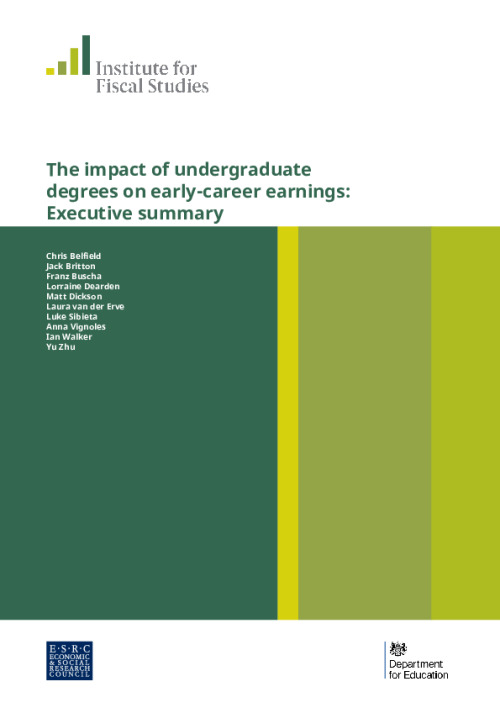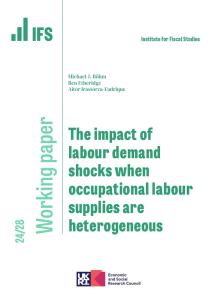This report uses the new Longitudinal Educational Outcomes (LEO) administrative dataset to provide the latest estimates of the impact of Higher Education (HE) on individuals’ early-career earnings after accounting for individuals’ pre-university characteristics. This will provide vital evidence for prospective students choosing whether, where and what to study at university.
We estimate the overall average impact of attending HE on earnings at age 29, and show how this varies for individuals studying different degree subjects or at different Higher Education Institutions (HEIs), based on those who went to HE in the mid- to late-2000s. We also investigate how these returns might differ for students with different prior attainment, based on their GCSE results and whether or not they studied a maths or science (‘STEM’) A-level. We focus on those who start HE, rather than just on HE graduates, as this is the relevant decision facing prospective students.
This is the second in a series of reports by the Institute for Fiscal Studies, commissioned by the Department for Education (DfE), that makes use of the LEO dataset to improve information on the value of HE degrees. The dataset, developed in collaboration with the DfE, tracks English students through school, college, university and into the labour market. This report, for the first time, uses the dataset to compare individuals who went to HE to those with similar background characteristics who did not.
All of our estimates (unless otherwise stated) report the effect of attending HE at age 18 on annual gross earnings at age 29, conditional on being in “sustained employment”. We compare our HE students with those who did not go to HE but had at least five A*-C GCSEs, controlling for differences in prior attainment, Key Stage 5 subject choices and family background.
This pioneering dataset enables us to account for many of the differences between those who do and do not attend HE, but there are many other factors which may affect this decision that are not accounted for, such as passion or preferences. Also these estimates focus on the monetary returns to university, which may not fully reflect the wider society benefits of these degrees. As such, some caution should be executed when interpreting these findings.
Our main findings are as follows:
- Those who attend HE earn a lot more on average than those who do not. At age 29 the average man who attended HE earns around 25% more than the average man (with five A*-C GCSEs) who did not. For women the gap is more than 50%.
- A large portion of this difference can be explained by differences in pre-university characteristics: a typical HE student has higher prior attainment and is more likely to have come from a richer family than someone who does not attend. They would therefore be expected to earn more, even had they not gone to university.
- Once we account for differences in pre-university characteristics, we estimate the average impact of attending HE on earnings at age 29 to be 26% for women and 6% for men. If we focus on the impact of graduating, these returns rise to 28% and 8% respectively.
- The higher returns for women may be driven by the fact that women who attend HE typically work longer hours than those who do not. This impact on working hours may well be causal, but it may also be larger at age 29 than at later ages if graduates delay having children.
- Importantly, age 29 is relatively early in an individuals’ career. There is strong evidence that the earnings of men who attend HE continue to grow faster than their non-HE counterparts after age 30. This is likely to result in the returns to HE for men being larger at later ages than we are able to estimate here. For women, the divergent trends in earnings by education type after age 30 are less clear.
- Not all degrees are the same, and subject choice appears to be a very important determinant of returns. For men, studying creative arts, English or philosophy actually result in lower earnings on average at age 29 than people with similar background characteristics who did not go to HE at all. By contrast, studying medicine or economics appears to increase earnings by more than 20%. For women, there are no subjects that have negative average returns, and studying economics or medicine increases their age 29 earnings by around 60%.
- Institution choice also appears to be highly important, as there is considerable variation in returns. For men, there are 12 institutions (accounting for 4% of male students) for which we estimate statistically significantly negative returns at age 29 on average, while there are 18 universities with average returns of more than 20%. For women, despite high returns on average, there are still two institutions (0.4% of female students) which have statistically significantly negative returns at age 29, while there are 66 institutions with returns of more than 20%.
- We estimate that 67% of men and 99% of women (and hence 85% of students) attended universities that have significantly positive returns on average by age 29.
- For both men and women, there is wide variation in returns within every subject and every institution. For example, studying at Cambridge yields positive returns of around 30% on average for both men and women, but some subject choices - for example creative arts - actually appear to result in lower earnings at age 29 than not going to university at all.
- The returns to HE also differ considerably for different types of students (see table). Attending HE only increases the age 29 earnings of lower prior attainment men (based on GCSE grades) without a STEM A-level by 4%. This compares to 20% for their peers who also do not have a STEM A-level but have high GCSE grades. The return is low because students with lower prior attainment are more likely to take low-returning subjects like creative arts, communications and sport science, and are more likely to attend lower-returning universities.
- However, this is not the only explanation: even when they study the same subject or at the same type of university as their peers who have higher prior attainment, they experience lower returns.
Table: Returns overall and by prior attainment subgroup
|
| No STEM A-level | STEM A-level | ||||
| All | Lower | Middle | Higher | Lower | Middle | Higher |
Men | 6% | 4% | 8% | 20% | 11% | 9% | 5% |
Women | 26% | 23% | 25% | 31% | 22% | 16% | 23% |
Note: These are percentage estimates based on Tables 9 and 10 of report
- This is a particularly important when considering the impacts of expansion in the HE system: in our period of study, 70% of all students with five A*-C GCSEs that did not attend university fell within this lower prior attainment, without STEM A-level group.
- Men with higher prior attainment and a STEM A-level have an estimated return of 5%, which might be lower than expected. This is hugely varied: studying law, medicine or economics increases their earnings by around 20%, and the return to attending a Russell Group for this group is around 10%. On the other hand, studying arts English, communications, psychology, languages and history, or attending Post-1992 or Other universities actually appears to result in lower earnings for this group than they would have achieved had they not gone to university (of course, these individuals may be making these choices for reasons other than to try to maximise their earnings). These particular estimates should be treated with caution, as overall only 5% of individuals in this group do not go to HE, and they are likely to be quite unusual - indeed, they have very high average earnings of around £40,000 per year by age 29.
- Among women, the overall returns to HE are high for all groups, though some similar patterns emerge. Higher prior attainment women without a STEM A-level have higher returns than their lower attainment peers. Unlike for men, there is little evidence of lower prior attainment women without a STEM A-level experiencing lower returns when studying the same subject as their higher attaining peers. Instead, the lower returns for this group appear to be driven by a higher propensity to study lower (although still significantly positive) returning subjects such as social care, sociology or education, and because they are more likely to attend lower-returning universities.













